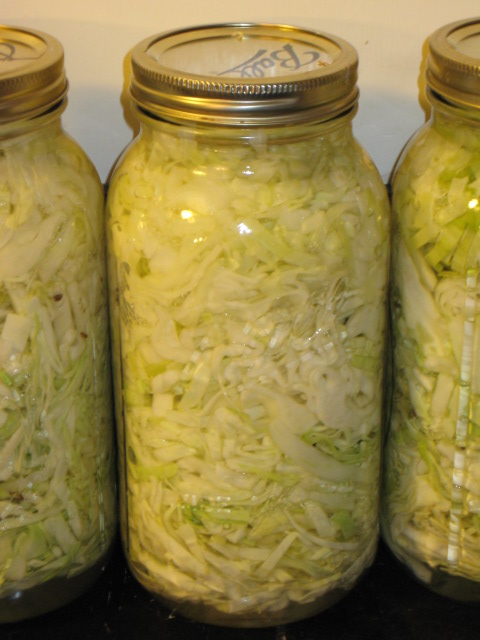With the aforementioned biggest head of cabbage I decided to give a first go at lactic fermentation. In a previous post I mentioned that last winter I purchased a book all about preserving food without canning or freezing. Among other methods, the book goes over lactic fermentation of numerous vegetables and I decided to start with sauerkraut.
I ended up going with a recipe in the book for glass jar sauerkraut. Despite my best efforts, I have not had any luck finding glazed stoneware crocks of any decent size. Of course I could go buy one, but they are damn expensive. And apparently I’d rather whine about not being able to find them, or send evil looks toward all those people who have a ton of them but don’t use them for anything. Apparently these old crocks are now a collectors item (since so few people do thier own buttermaking, fermenting, pickle making, etc). So there are tons of crocks sitting on display shelves, or hoarded in someone’s basement instead of being put to use. The side effect of this ‘antiques’ business is that the price of any stoneware on ebay or craigslist is through the roof, even if they aren’t old.
However, I do have a dozen half gallon canning jars from this spring’s Craigslist purchase. This seemed like a good opportunity to use them. As we are usually only two people here, canning anything in half gallon quantities is a bit dubious. We would likely not get through it fast enough once the seal is broken. However, lactic fermentation does not require a seal, so we can chip away at the stores with less of an impending sense of doom (or rotteness). Once the kraut is done, I could also can it up in smaller jars if I like.
The recipe was quite simple. Grate or slice cabbabe and densely pack into sterilized jars, layering any spices or herbs you want among the cabbage. I snipped a couple of bay leaves from the tree out back and added those with a sprinkle of caraway every 3 inch layer. Once jar is filled with cabbage, add 1 tablespoon salt to the top for each quart of cabbage and fill to cover with hot water. Place lids on jars and set aside.
The instructions say to leave the sauerkraut in the kitchen for about 3 days before storing. I assume this is to expose the kraut to warmer temps to jumpstart the action before storing in a root cellar or basement (for all those lucky lucky souls that have such a thing). For now the jars are sitting on the kitchen counter and in a few days they will make thier way either to my office or out to our unheated workshop. Who knows if this’ll work out, but I am sure curious to see! Our one giant head of cabbage translated to 4 half gallon jars of kraut, so we will have plenty if it is tasty .



0 responses so far ↓
There are no comments yet...Kick things off by filling out the form below.
Leave a Comment